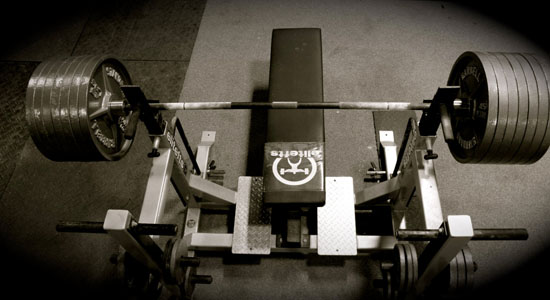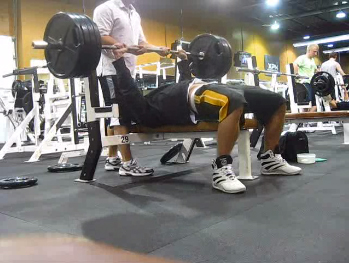Pushing Strength: The Bench Press - Part 2.
 Picture from Elite FTS.
Picture from Elite FTS.
In Part 1 of this series for the Bench Press (click here for Part 1), we have looked at setting ourselves up for a biomechanically efficient lift. I always believe that the start of any movement determines the outcome of the movement. If you start well, you will finish well and gain the most out of it.
Today, we will address the execution of the movement itself. This discussion will be broken down into Racking the Weight, the Eccentric Phase (downward movement), the Bottom Position, and the Concentric Phase (upward movement).
Racking The Weight
This is the next step you take after you have a good set-up position. Should you be going heavy around 1-5 repetition-max, you had better have someone helping you with this. The spotter should be standing behind the bar and assisting you in lifting the weight off the rack.
Picture from SeriousTeenBodybuidling.com
Key Points When Racking The Weight:
- Make sure you have the right grip on the bar.
- Spotter and lifter in unison in lifting the bar off the rack. This can be in the form of a verbal command by the spotter: "1, 2, 3.." then the bar gets off the rack with the effort of the spotter and lifter.
- Ensure that the lifter has arms locked out when the weight is off the rack.
- Only when lifter is stable and arms are locked out, the spotter releases his hold on the bar and gives the full weight of the bar to the lifter. The spotter can also use verbal cues such as "The bar is yours." allowing the lifter to expect the full load of the bar at this moment.
The Eccentric Phase (Downward Movement)
Now you have literally felt that load on your arms and shoulders and you are thinking of lowering it down for your rep. This is also the point where gravity kicks in and you are going along with gravity. With that, you can build more strength to the increased muscle damage from the help of gravity.
Picture from T-Nation.
Key Points for the Eccentric Phase:
- Always start with a big breath of air before any big lift. This allows a build-up of inter-abdominal pressure to support the stability of your spine.
- Once you are ready and your trunk is tight, focus on keeping all six points of contact as mentioned in the set-up (i.e. feet, shoulders and glutes) and begin lowering the weight down to your chest in a controlled motion.
- The more time you have under tension, the more muscle damage you will induce and the more strength you will gain with proper recovery.
- At this time, also keep the elbows close to your body to activate the lats as you lower the weight. It also allows for the shoulders to be more stable under a tremendous load.
- While you lower the weight, guide it to finish in a position close to the bottom of your pecs or below your nipple-level. Hence, the need to lower it in a controlled manner.
- Breath is to be held throughout the eccentric phase to maintain the abdominal pressure for better stabilization of the trunk.
The Bottom Position
The question is always how low you should go for the big lifts. My answer to that is as low as you can because each time you bring the weight to a low level, you actually allow your muscles, ligaments and tendons to stretch under load, hence training for more flexibility. Thus, for the Bench Press, bring it as low as you can and even till the point you touch your chest so that you develop that strength and flexibility in your shoulder gridle throughout the whole range of motion.
Picture from WannaBeBig.
Key Points for the Bottom Position:
- Never let the weight crash onto your chest at the bottom. It may cause you to lose the inter-abdominal pressure from the holding of your breath which may cause injury to your ribs.
- The weight should be controlled and not bounced off at the bottom position.
- The moment the weight is felt touching on the chest, you should already be thinking of exploding and pushing the weight back up.
The Concentric Phase (Upward Movement)
This is the most important portion of the lift and where the most work and force is required to successfully perform the lift. Gravity is acting against you at this point and it is important to be explosive during this phase especially under large poundages.
Picture from Elite Kinetics.
Key Points for the Concentric Phase:
- The six points of contact should still be maintained and you should actively push your heels into the ground to develop more stability and drive for the movement.
- The sticking point is the point hardest to overcome if the weight is heavy. Hence, an explosive movment to initiate the concentric phase allows you to be able to use velocity to overcome this sticking point.
- The wrong way of being explosive is exactly how many gym junkies do their benches: by bouncing it off their chest.
- The breath should still be held as you explode off till you reach close to the sticking point, then you breathe out forcefully to assist in pushing through.
- Spotters need to be more cautious at this point because this is where most people who fail the lift. So a quarter squat position should be adopted and a firm grip on the bar is required should you fail the lift. If it is a much heavier weight, two additional spotters should be at each side of the barbell to help with spotting (as pictured above)
- A successful attempt at the bench press would be to have the arms fully extending in a stable position with the weight in control.
- The spotter needs to have a firm grip on the bar without providing any assistance till required to prepare for a situation of failing the lift.
- Racking the bar whether successful or not, the spotter assists by fully extending his body from the quarter squat position and pulling the bar back into the rack till it's safely returned to the rack.
So this is the entire process of the execution of the Bench Press explained in as simple points as possible. Stick to these points to help you safely and successfully (with proper technique and consistent training) execute the Bench Press in your strength & conditioning programs. You will know you will be stronger in the movement of your lift and be able to lift heavier weights pretty consistently if you do the movement correctly.
Next part of the series will be a discussion on the variations of the Bench Press and a few assistance exercises you can perform to help improve your Bench.
Should you have any questions or require more information, feel free to drop me a message and we can have a chat about it!
Stay Strong and Keep on Benching,
The Training Geek.
P.S. Now The Training Geek is also on Twitter, Facebook and Linkedin!




